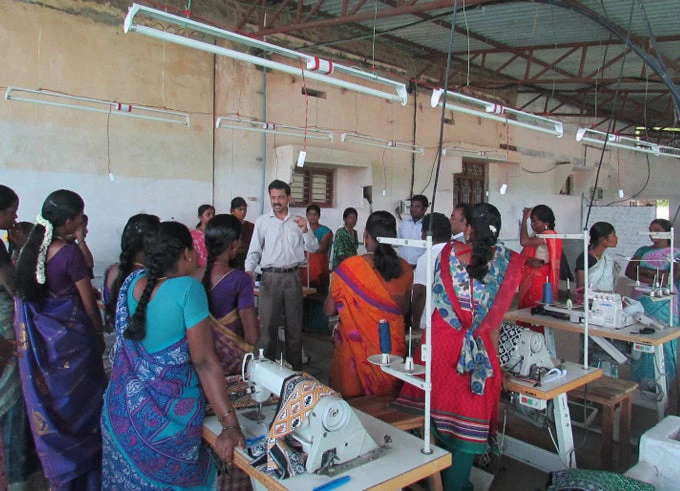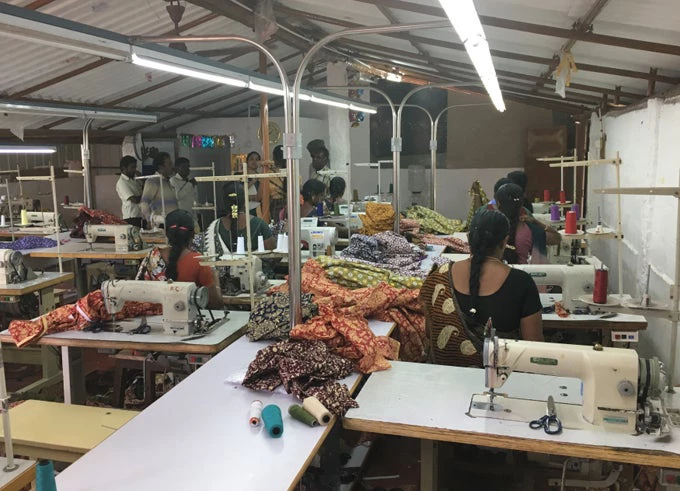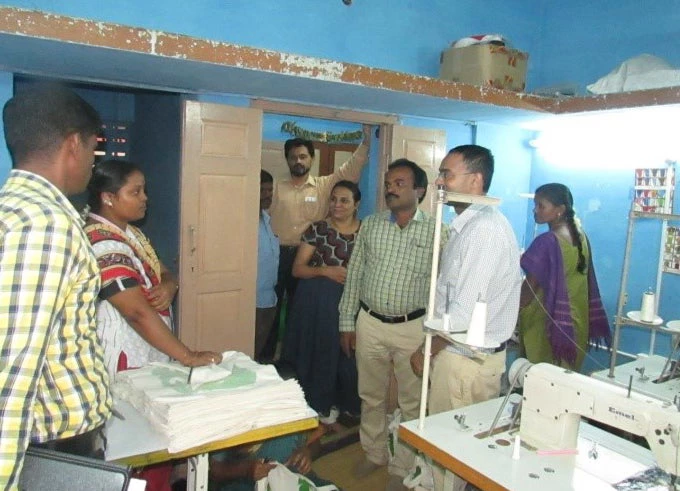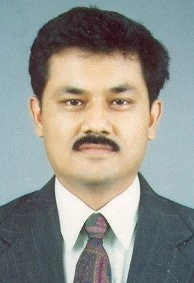As we entered the small hut of rammed earth thatched with coconut leaves, the sounds we heard belonged to a different world. Amidst the whir of industrial sewing machines, nine young women were busy stitching bolts of fabric into men’s shirts, destined for India’s vast domestic market for low-cost garments.

This was Inam Koilpatti village in India’s southern state of Tamil Nadu. Even though many villages in the state were rapidly urbanising, this village still had many huts, and prosperity was yet to arrive.
Two young women, Indhurani and Gurupakkiam, ran this tiny unit. Born with an entrepreneurial spirit, these women have unwittingly given a much-needed boost to the idea of ‘Start Up India’ in this poor region.
“We were both working at a company in Thalavaipuram,” they began. (Thalavaipuram is an emerging garments hub nearby.) “But, with family responsibilities it was getting hard for us to travel 20 km to work. Three years ago we approached our employer with a proposition. We would set up a unit in our village, if he would give us orders,” they narrated.
Persuading their manager was not difficult. The women were known for their good work, and besides, the state’s garment industry was in the grip of crippling labor shortages.
Once their manager agreed, the women dipped into their meagre savings, bought two old industrial sewing machines, and got them refurbished. Since there was little money left, they converted a part of their small thatched homes into the factory floor.
After reinvesting their profits, the women were now operating nine machines, employing ten women, and running the unit year around. The home had been vacated and the small hut was entirely a shop floor now.
The garments industry is one of the dominant industries in Tamil Nadu. And Tiruppur, its main center, has earned a place on the global map for garment manufacturing. The industry, however, faces huge shortages of skilled labour. “Twenty thousand people are needed in Tiruppur alone,” said the leader of the garments association.
On the other hand, there is an abundance of skilled labor in the countryside. Many of Tamil Nadu’s rural women have rich experience working in large garment factories, but marriage and family responsibilities have forced them to return to their home villages. Our project – the World Bank’s Tamil Nadu Empowerment and Poverty Reduction Project (TNEPRP) - had also trained large numbers of village women in tailoring, a trade that was popular among them.
But despite these thousands of skilled women, there were very few tailoring enterprises in the villages – just a few tailoring shops catered to village demand, or for the seasonal need for uniforms from local schools.
A bridge needed to be built between the industry and the skilled workforce, each separated from the other by geography.
Setting the stage for change
But how? Indhurani and Gurupakkiam were showing us the way. Their lack of education did not prevent the flowering of their enterprise. Or maybe it spurred them on!
Who, then, would build this bridge? Shunmugaraj, the TNEPRP project’s district manager in Virudhnagar district took up the challenge in great earnest. He had seen the hunger for work in the eyes of the rural women, and was convinced that companies could double their annual turnover if only they could somehow employ them. Markets were not a problem - exports to the Middle-East were growing and the scope for further expansion was huge.
There was one stumbling block, however. The managers of the big garment units in the Thalavaipuram hub nearby were not keen to outsource work to these simple village women. To them, a village exuded an air of inefficiency and disorderliness, and they felt that poor and little-educated rural women could not be good managers.
Step-by-step Shunmugaraj convinced these reluctant managers, telling them that for every woman who worked with them, there were at least two more who could work out of their villages. What’s more, some of these women were very enterprising, and the project could help them set up small manufacturing units with financing and mentoring.

An idea whose time has come
At first, three managers agreed to experiment. If the village garment units were able to reach the performance levels required of them, they would place their orders with them.
Three months later four units emerged and hit the required performance levels. Six months later the number grew to twenty. And, applications from another twenty are pending. Shunmugaraj and his team had done an excellent job of bringing the community and industry together.
Carefully identifying those with entrepreneurial ability, the project helped the women set up small garment units. For the first three months the project provided the women with handholding, introduced customers, facilitated financing from government departments and banks, helped get mandatory registrations and certifications, located machinery suppliers, provided training in entrepreneurship, and mobilised labour. After three months, the women were largely on their own, a condition that had been agreed upfront with them.
Today Virudhnagar district has 20 small garments units that employ more than 200 women, many of whom have switched from farming or unskilled jobs, or from hazardous jobs in fireworks units. With well-paying jobs available near their homes, the women now enjoy a vastly better lifestyle, and work in a profession they have always aspired for.

Creating brands of their own
When the experiment began, Bhanu, an entrepreneur, had told us, “I would like to have my own brand one day.” A year later, while Bhanu still manufactures for a few large companies, she has also launched a brand of her own. As is often the case with start-ups, her business partner, Fathima Beevi, has split amicably, but by setting up her own unit, has generated further employment.
Andal, another entrepreneur, started with just five machines and within six months had expanded them to twelve. Elsewhere, ten women have come together, pooled their resources, and set up a 10-machine unit that is doing good business.
Some of the top garment manufacturers in Thalavaipuram now partner with all fifteen of these small women’s enterprises. And, mortality among these new units has been low.
Building on this success, the World Bank’s proposed Tamil Nadu Rural Transformation Project is seeking to carry on the good work by integrating more rural women into the value chains for other industries - horticulture, food and agro-processing, dairy, leather and handicrafts - and scaling up their enterprises across the state.
As India struggles to generate jobs and increase female labor force participation in the country, Indhurani and Gurupakkiam’s pioneering enterprise is showing the way. Clearly there are some enterprising ‘jewels’ among India’s forgotten billion. All they need is a chance to shine their light in their full glory, and take others along in the process.
Authors acknowledge contributions by Shouvik Mitra for the case studies and data.



Join the Conversation